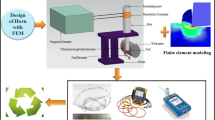Abstract
The experiment is carried out of turning W-Fe-Ni alloy by conventional turning and ultrasonically assisted turning. Effects of cutting parameters and vibration parameters on surface roughness are studied. The significant factors influence surface roughness by the orders of feed rate, tool amplitude and tool frequency in ultrasonically assisted turning, whereas the main factors influence surface roughness is feed rate in conventional turning. Using ultrasonically assisted turning can reduce surface roughness by 7.05%30.06% compared with conventional turning in same cutting parameters in experiments. To analyze the characteristics of surface machined, X ray diffractometer, white light interferometer and scanning electronic microscope are used to observe micro surface profile. It is confirmed that apart from the regular feed marks with an equal spacing, there are also regular parallel stripes on the finished surface in ultrasonically assisted turning. It is intense ironing effects that reduce the surface roughness and increase compressive stress. A high quality surface can be obtained by selecting appropriate parameters in ultrasonically assisted turning.
Access this chapter
Tax calculation will be finalised at checkout
Purchases are for personal use only
Preview
Unable to display preview. Download preview PDF.
Similar content being viewed by others
6 References
V.I. Babitsky, A.N. Kalashnikov, A. Meadows etal. Ultrasonically assisted turning of aviation materials [J]. J. Mater. Process. Technol. 132(1–3)(2003):157–167.
A.R. Sharman. P. Bowen,etal. Ultrasonic Assisted Turning of Gamma Titanium Aluminide, Rolls-Royceplc,2001.
A.V. Mitrofanov, N. Ahmed, etal. Effect of lubrication and cutting parameters on ultrasonically assisted turning of Inconel 718 [J]. J. Mater. Process. Technol. 162–163(2005):649–654.
V.I. Babitsky, A.V. Mitrofanov, V.V. Silberschmidt. Ultrasonically assisted turning of aviation materials: simulations and experimental study [J]. Ultrasonics42(2004):81–86.
Jeong-Du Kim, In-Hyu Choi. Micro surface phenomenon of ductile cutting in the ultrasonic vibration cutting of optical plastics [J]. Journal of Materials Processing Technology. 68(1997):89–98.
X. Wang, M. Zhou, J.K.G. Gan, B. Ngoi, Theoretical and experimental studies of ultra precision machining of brittle materials with ultrasonic vibration [J], International Journal of Advance Manufacturing Technology 20 (2002) 99–102.
Author information
Authors and Affiliations
Editor information
Editors and Affiliations
Rights and permissions
Copyright information
© 2008 Springer-Verlag London Limited
About this paper
Cite this paper
Chen, J., Tian, G., Chi, Y., Liu, M., Shan, D., Liu, Y. (2008). Surface Roughness and Microstructure in Ultrasonically Assisted Turning of W-Fe-Ni Alloy. In: Mitsuishi, M., Ueda, K., Kimura, F. (eds) Manufacturing Systems and Technologies for the New Frontier. Springer, London. https://doi.org/10.1007/978-1-84800-267-8_90
Download citation
DOI: https://doi.org/10.1007/978-1-84800-267-8_90
Publisher Name: Springer, London
Print ISBN: 978-1-84800-266-1
Online ISBN: 978-1-84800-267-8
eBook Packages: EngineeringEngineering (R0)



